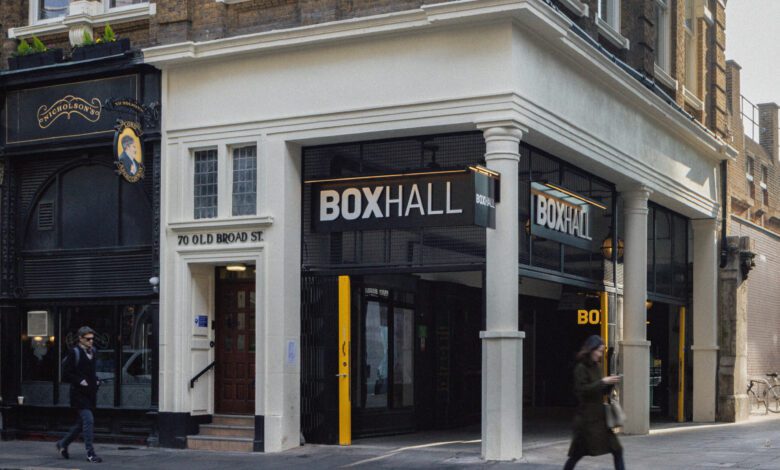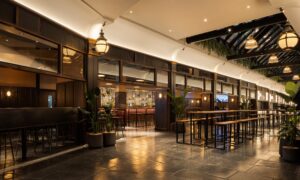Thinking outside of the box: Why is Boxpark trying a new concept?
Catering Today talks to Matthew McMillan, head of development at Boxpark and Mike Sinclair director from architects Macaulay Sinclair about the benefits of the new Boxhalls concepts, the challenges is presents and the future of the market halls concept

Since its inception in 2011 Boxpark has had a simple business model, using shipping containers to build a market hall style hospitality venue, always trying to be agile and cheap. However, 15 years on Boxpark is taking the next step by unveiling its new Boxhall concept in Liverpool Street, a more permanent type of concept for the brand. Why has Boxpark decided to introduce this new concept, what are the benefits and challenges that come with it and is this concept the future of the market hall dining scene?
A new home
The most obvious difference between Boxhall and Boxpark is that Boxhall has been built in an already existing building, which is new for Boxpark. According to Matthew McMillan, head of development at Boxpark, this new concept is an “elevated version of what Boxpark is”. McMillian explains that the company has looked for two things while developing the concept, interesting buildings in central locations and an elevated presentation. For Boxpark this new concept is the next evolution in the business.
“What we were looking for is central city sites. Boxhall is not anywhere near as events led as Boxpark but we are really developing our architecture and the way we present so we have something that is much more permanent and actually has a longevity beyond the timelines we’ve looked at before,” he explains.
From an architecture perspective Mike Sinclair director of Macaulay Sinclair states that the new concept is different as the classic Boxpark concept are vast square footage sites whereas the building in Liverpool Street is more restricted but it is “steeped with nostalgia, historic reference and conservation areas”. The main idea behind the concept is to repurpose and regenerate unused or existing sites into something new and modern.
Away from the architecture of the building, the new concept has given the people at Boxpark a chance to develop something new and subvert the old tried and tested formula. “It’s brilliant to kind of spread the wings of the business and actually come up with a new way to do things. The nature of these buildings is that we can’t do the big atrial spaces therefore you do progress the concept slightly differently. So you’re not going to rely on the same sort of things to bring people in,” says McMillan.
“How many times do you have an opportunity to dine in a metropolitan arcade? An Edwardian shopping arcade built in 1912 full of loveliness, lovely eye candy. It’s such a sort of iconic space, not just the way in terms of where it sits, and what it used to be, but just the space itself, long, linear space, lovely, natural light above. I think it’s going to be a hugely successful not just place to go and dine, but I think people will be a very memorable space.”

New concept, new challenges
However, while Boxpark is excited about its new concept, building in existing buildings, especially ones in prime locations such as Liverpool Street, presents a host of challenges which the company has not faced before. For one, having a permanent building means the company has to get different kinds of permissions. Boxhall is located opposite Liverpool Street station immediately above the tube lines. Furthermore, while the building itself is not listed, it is old and that brings a number of challenges and regulations.
“There’s lots of permissions and additional consultants involved to make sure that the venue safeguards the loveliness and the architectural fabric of the building, but also health and safety issues as well. It’s also an incredibly restrictive site, working in the City of London and getting materials and access and work permits, and just generally getting to the site brings challenges,” Sinclair says.
Would the success of Boxhall spell the end of Boxpark?
With the launch of a new concept it begs the question whether Boxpark is looking to completely change its business model and abandon the less permanent shipping container design. This comes not long after Boxpark had issues with the lease of its venue in Shoreditch just down the street from Boxhall.
However, McMillan explains that this is not something the company is looking to do but rather it is looking to adopt a horses for courses sort of approach. If Boxhall is a success the company will be able to look at a number of different locations and decide which model will fit which location. McMillian states that there are not a plethora of prime central city sites for venues like Boxhall, so the brand has to be particular.
“Boxpark has done a spectacular job where it’s been landed in places where there’s been huge scale regeneration, where you’ve got 60 or 70 hectare schemes coming up, and they need new hearts. They need a bit of London transposed into the middle of them. So that works in those contexts. With Boxhall there’s not a lot of these plots in London, but there are great spaces where we’re really considering transport and interesting building architecture. We’re looking at where else we can execute it,” McMillan states.

